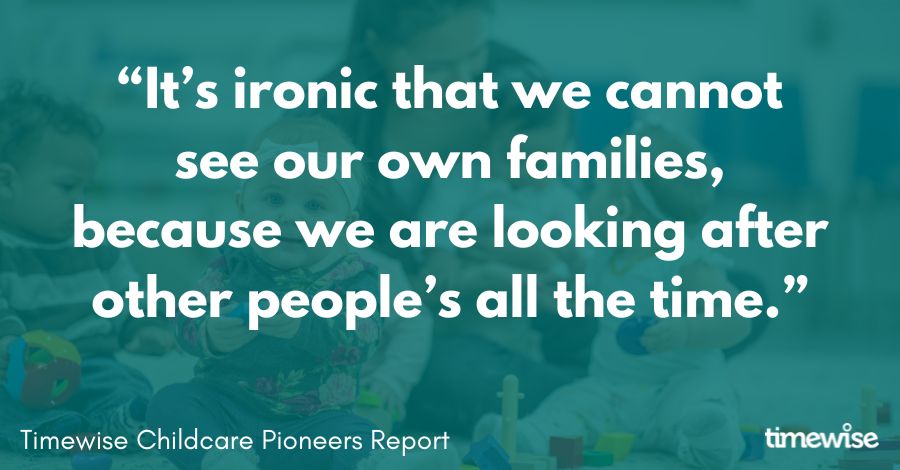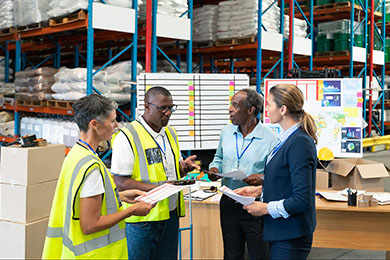

Timewise CEO Clare McNeil looks at what this means for employment rights, work and health.

By Clare McNeil, Timewise CEO
The departure of Angela Rayner and machinery of government changes we have seen in the last few days have exposed some of the tensions that surround the government’s approach to one of its most high-profile pieces of legislation, the Employment Rights Bill. It has also raised questions about whether we are likely to see ‘continuity or change’ in regard to this.
Even before the government reshuffle, the government was facing questions about its intent on the Employment Rights Bill, given the long timescales for implementation of key measures and a lack of resources focused on implementation and enforcement.
But with a new ‘super-ministry’ at the Department for Work and Pensions (DWP) which is expected to incorporate adult skills under the new Secretary of State Pat McFadden, the drawbacks of this approach may become more apparent. The very groups DWP (and HM Treasury) urgently need to get back into the workplace – those who are economically inactive due to disabilities and long-term sickness and their parents and carers – are mostly likely to do so with exactly the flexible, secure and predictable work the Employment Rights Bill encourages employers to offer. For example, as many as two-thirds of disabled people who are currently not working and receiving incapacity or disability benefits need to work flexibly or part-time to get back into work, as the Resolution Foundation recently found.
One of the arguments against the proposed legislation on flexible working and zero-hours contracts is that it is unworkable. But look at what businesses are doing rather than what lobby groups are arguing on their behalf: increasingly employers are offering minimum guaranteed hours, giving workers more say and control over their shift patterns and fair notice of both schedules and changes to stay competitive in a challenging recruitment market. We published many examples from leading employers in Timewise’s Ending the Two-Tier Workforce report earlier this year.
The expected transfer of adult skills into the DWP portfolio raises hopes of closer working with the Department for Business and Trade (DBT) on a whole set of issues – from the role of employers in young people’s employment, to improving poor employer utilisation of skills which leaves so many talented (often part-time) workers behind and businesses missing out on talent. Even before these changes in government, a busy autumn was shaping up on the work and health front. Three key events Timewise will be focused on:
The Employment Rights Bill will be the subject of ‘ping pong’ between House of Lords and parliament over the next few weeks. House of Lords amendments have paved the way for key proposals on offering guaranteed hours to an employee and paying for cancelled shift work to be removed or watered down.
One of the arguments against these proposals is that they are unworkable. But Timewise has worked with many employers who are voluntarily adopting these ways of working to recruit and retain the best staff. See positive examples from employers such as WH Smith (TG Jones) and Timewise advice for employers here:
We can’t simply legislate our way to better work. In spite of the many pressures facing business, Sir Charlie Mayfield is likely to argue in his Keep Britain Working review that it is in business interests to work with government to tackle rising working age ill health. In our response to the consultation Timewise argues a key test for the Review will be whether it can make a difference for the ‘deskless’ workers in frontline sectors where rates of inactivity are highest – like retail, transport, health & care and construction. That means a voluntary framework alone is unlikely to be enough.
We’d like to see agreements for employers, workers and experts to come together to drive up standards, reduce sickness absence and improve retention rates. The White Paper expected from DWP this Autumn is another vital chance to influence employer behaviour to create the part-time and flexible work those with health conditions and disabilities vitally need.
With more public sector strikes potentially on the horizon for this Autumn, we must recognise that pay is just one factor. Surveys of frontline workers show that self-respect, dignity, autonomy and flexibility at work matter as much as levels of pay. Denied requests for flexible working, heavy workloads and the introduction of new technologies are taking their toll on public sector workers.
Expected workforce plans in health, education, childcare and the fair pay agreement for social care are a chance to turn this around. Critical to this is what the TUC are calling a pro-worker strategy on AI: the use of gig work apps and workforce scheduling tools, for example, can make work more insecure, increasing worker surveillance and undermining regulation. Improving insights into the best and the worst of these technologies is vital and a key focus for Timewise in the months ahead.
Published September 2025
The vast majority of people who become economically inactive leave (and are most likely to return to) sectors dominated by shift-based and site-based work. The top five are retail, transport, hospitality, health and care, followed by construction. Workers frequently face rigid schedules and tough working conditions which can make it difficult to find the flexibility or predictability they need to accommodate a disability, health condition or caring responsibilities.
What limited support is available through Department of Work and Pensions (DWP) programmes to tackle this is too focused on making people more suitable for unsuitable jobs. Instead, more state support needs to be directed at supporting employers to influence the way work is designed and managed in these sectors if we are to see meaningful change in disability employment gaps or economic inactivity rates.
The government’s welfare reform White Paper this Autumn, the independent review led by Sir Charlie Mayfield and the phased implementation of the Employment Rights Bill offer a vital chance to achieve this shift. But this requires closer working with industry, unions and experts to negotiate agreements to achieve common objectives in sectors that face real operational constraints and obstacles to designing work differently and which often involve practices that cause or exacerbate health issues at work.
In this critical window to change the way we work for the better, Timewise is arguing for changes including:
Published August 2025

By Nicola Pease, Principal Consultant, Timewise
We can all agree that any functioning society needs an excellent system of early years and childcare provision. At present, our high quality early years educators are managing to provide a great service, but many are stressed, exhausted and have little to no work-life balance. In short, it’s an early years system on the edge.
While issues around pay and progression loom large with no immediate resolution in sight, let’s look to what we can fix. Building on recent successes in other shift-based, site-based sectors such as nursing, construction and retail, Timewise launched a report following an in-depth two-year project in the early years and childcare sector. Thanks to support from JPMorganChase we were able to partner with two leading childcare providers: the Early Years Alliance and the London Early Years Foundation, and get close to childcare staff, in settings.
We analysed the industry’s challenges and assessed its potential with regards to improving staff wellbeing through changes to working patterns. Sometimes, even the smallest changes can make an enormous difference. We conducted all our research and analysis whilst keeping the experiences of children and parents front of mind. If this is going to work: it has to work for everyone.
We held a packed event in Westminster, with support from the Early Education and Childcare Coalition, to launch our subsequent report, Building the early years and childcare workforce of the future, with early years providers, policymakers and local and national government representatives. We collaborated on ideas and sharing ‘what works’ at settings across the UK. All with the experience of children and quality of education and care, front and centre of our thinking. Read on, to find out more…
The early years sector is facing a perfect storm – the expansion of 30 hours funded childcare will require an additional 35,000 staff across the UK, yet 78% of providers in a recent survey said they are already struggling to attract people to a sector that is not competitive on pay or working conditions. 62% of the workforce earn less than the living wage, with pay rates similar to roles in retail and hospitality, that are arguably less physically and emotionally demanding – and sometimes offer more flexibility in terms of what shifts and hours people can work.
There is also an increasing number of pressures on our early years educators which is driving up their workload and making the job harder. For example a growth in the demand for longer-hours provision to meet the needs of parents and (as was raised numerous times at our event), a hugely increased number of children presenting with SEND. All this notches up the pressure gauge.
The research found that nearly two-thirds of staff in group-based settings have said they do not have good work-life balance.

Part-time work across the sector has fallen in the majority of settings since 2018-19 with flexible working options generally achieved through the use of casual, agency or bank staff.
Managers recognised the potential benefits of offering flexible working but were concerned about continuity of care, maintaining staff-child ratios, meeting training standards, ensuring fairness and managing team dynamics. As one person described life in a nursery, “It’s a constant jigsaw.”
At the roundtable we heard a clear call to value those working in Early Years more highly, recognising that, “It’s not just about numbers, it’s about ensuring those who care and educate are energised, valued and motivated to do so.” There was an acknowledgement that emotional resilience is key in a workplace that demands a high level of emotional investment in children’s development and needs. And a sense that there is a need to better balance the workloads and schedules of those in such an intense working environment, to better support physical, mental and emotional wellbeing.
Increasing access and opportunity for the sector is a challenge, but through the research and numerous examples of good practice, it was proven to be possible within the operating constraints of the sector – all with the voice of the child front and centre. Innovative work practices included split-shift patterns (read Ruth’s story on page 11 of the report) and recruiting lunchtime assistants (page 18 of the report), housekeepers or tea-time assistants who enable flexibility across the wider teams. As Neil Leitch, Chief Executive of the Early Years Alliance put it, “You have to be creative. Continuity is critical but that does not mean you need always to see the same person.”
And it can also be used to enhance an organisation’s management capabilities. As June O’Sullivan OBE, the Chief Executive of LEYF said, “We need to think creatively about flexibility, in its wider context. For example, think flexibly about how you think about succession planning. It can help planning the next steps for staff or an experienced manager phase their retirement slowly, while helping a new manager to build their skills and knowledge.”
At a national level, Timewise is calling for a workforce plan that includes flexible working as a key strategic pillar. We estimate that a recruitment drive based around part-time and flexible working could attract staff to fill the equivalent of 17,850 full-time vacancies. That’s half the 35,000 shortfall the UK currently faces, to meet the expansion of 30hrs/week funded support.
Locally, we need authorities to bring networks of childcare providers together to share learnings, consider challenges and how to overcome them by exploring innovative practices such as sharing of bank staff. There was real momentum at our event around this idea – clearly they have a real ‘binding’ role to play. And for childcare providers themselves, we need to see a shift away from an individualised request-response model of flexibility towards a more pro-active whole-setting approach that encourages creativity and innovation and enables staff input into working patterns. To support this, Timewise have created a series of toolkits and resources for managers, which can be found here.
There is no magic wand with which to fix the staff and people problems that the early years sector is facing. But creating good standards of flexible working, in an industry where 98% of employees are women, many of whom have their own caring responsibilities, is not just good business sense. It’s a way to improve wellbeing and the lives of those playing the vital role of nurturing our future generations.
Despite being a critically important sector for the UK’s economy and society, childcare providers are struggling to recruit and retain staff. Delivering good quality early childhood education and care is key to enabling parents to work and contribute to economic growth, yet staff are facing longer hours and lower pay than comparable occupations for what can be more emotionally and physically demanding work.
This is not sustainable and action must be taken to improve staff satisfaction and to make those working in early years education feel more valued and supported. The pressure on the sector will only increase further as the government rolls out the funded childcare entitlement expansion over the next year, forecasting that an additional 35,000 new places for zero to two-year olds will be needed by September 2025.
The Timewise Childcare Pioneers project explored how proactive flexible working cultures could improve staff wellbeing and engagement and attract a more diverse pool of candidates – such as older workers and those with caring and health responsibilities.
We worked with the Early Years Alliance, representing 14,00 members, and the London Early Years Foundation, representing 40 nurseries, to explore the role improved flexible working could play in tackling the current workforce crisis facing the sector, and to understand what improvements are possible without compromising the quality of education and care that meets the needs of parent and children.
Then we designed and delivered a set of activities and tools to support nurseries to be more consistent in their approach to flexible working, and to help them to consider and trial new approaches to increase the availability of quality flexible work.
Our thanks to JPMorganChase and Trust for London for supporting this project.
Our initial diagnostic work found that part-time and flexible working is relatively common in childcare provider settings, and steps had been taken by both nursery providers to improve the information and support available to nursery managers to help them respond to flexible working requests fairly and consistently. However, staff felt that these arrangements were sometimes rationed, and their requests were not always seen as significant. They also felt that many managers set shift patterns without their input, and organisational needs were considered above staff needs, leaving them feeling less valued and less able to balance work and life commitments.
Head office staff and nursery managers highlighted that flexible working could make it harder to meet statutory staff-child ratios, recommended training standards, parents’ needs for flexible care, and provide continuity of care for the children. Managers are under pressure to juggle all these factors when setting schedules and are concerned that having more part-time staff and enabling flexible working patterns for some individuals would negatively impact others’ workloads.
“It’s really difficult because everything that we do is planned around ratios. And if you’ve already got a certain number of children and you’ve hit your maximum number of children with the staff that you’ve got, being flexible isn’t always possible.”
Nursery manager
“Flexible work works better in some types of settings than others. It depends very much on types of funding and types of hours parents need… More affluent areas means less availability of the 15 hour entitlement for two-year-olds, with an increasing focus on parents working three long days a week and wanting Monday and Friday off. Staff say Tuesday to Thursday are very mixed days and then Friday is half empty and Monday mixed. This has particular implications [for nurseries] as often the parents who want this have babies, and baby care needs high ratios and consistent care. Nannies and grandparents are also in the mix in different proportions in different settings.”
Director, nursery group
We found that leaders, managers and staff in nursery settings were keen to make improvements to their flexible working offering to help retain and attract staff, provided operational challenges could be overcome. With limited capacity to pilot new approaches due to high workloads and staff shortages, our project focused on improving the confidence, skills and knowledge gaps of nursery managers with a set of resources and tools.
The project showed that it is possible to improve flexible working in the childcare sector, and that this can be one part of a solution to current workforce challenges. However, it also highlighted the need for practical support to help employers implement changes in a sector where funding constraints and acute staff shortages are limiting the capacity for innovation.
If flexible working is to be adopted more widely across the sector, it is clear that concerted action is needed at both local and national level.
How to attract and retain talent through enhanced flexibility for the workforce
Published November 2024

By Dr Sarah Dauncey, Head of Partnerships and Insight, Timewise
Occupational segregation is a distinctive feature of the UK’s labour market and a driver of persistent inequality, in income and more widely in health. Workers from black and minoritised ethnic groups are overly represented in sectors where site-based, insecure and lower-paid work is prevalent. People from minoritised groups are also more likely to have a higher risk of developing long-term health conditions, which can affect people’s ability to work – especially in site-based and more physical roles. The pandemic exposed the health inequity arising from this, with minoritised ethnic groups disproportionately impacted because of the increased likelihood of being a frontline worker without the option to work from home.
These patterns are too often replicated within organisations, with people from minoritised ethnic groups overrepresented in lower-paid, site-based roles and functions like security, cleaning, catering and caretaking which typically have more limited access to flexible options. Where an organisational focus is on hybrid as a flexible option, disparities are intensified. Further, within their workplaces, workers from minoritised ethnicities can experience a sense of precarity or inferiority that restricts their confidence to challenge decision-makers and request reforms to conditions or working patterns for fear of losing their job.
This means that workers from black and minoritised communities are overall less likely to make the most of the workplace benefits that support better health. This includes the improved work-life balance that comes from better autonomy and flexibility. Unhealthy working conditions contribute to ill-health, and ill-health restricts people’s ability to work, creating a cycle that is increasingly difficult to overcome in the context of the rising cost of living.
It’s in the context of this structural inequality that Runnymede and Timewise established a partnership, with the support of Impact on Urban Health. We wanted to better understand the relationship between flexible working and organisational approaches to equality, diversity and inclusion, and how site-based workers from black and minoritised ethnic backgrounds perceive and experience flexible working.
More specifically, we wanted to find out how new ways of working supported or thwarted a sense of inclusion and belonging. This involved us speaking with two stakeholder groups in participating organisations, leaders of site-site based teams and their employees. We took an action-oriented approach to our research, ensuring that our insights drove meaningful change in participating organisations to address processes of exclusion.
The recent racist rioting, driven by a combination of routine, normalised discrimination – heated-up over recent years by mainstream politicians and media – has raised the stakes of our research and its implications for both workers and organisations. Our interviews were undertaken early in 2024. We heard workers’ sense of fear, their reluctance to ‘rock the boat’ and ask for working patterns that might challenge ‘ideal worker’ (i.e. white and male) stereotypes. People who have experienced, or are experiencing, racial trauma invariably have a different set of expectations about their level of input and control over their working pattern.
During the riots, we read harrowing accounts in the mainstream media of people facing physical and verbal threats because of their skin colour or religion, instilling fear among people from black and ethnic minorities across the country. While we welcomed hearing about employers who led with empathy and offered increased protections to their employees, including the opportunity to work from home if they were able to, we were mindful of the risks that site-based workers had to face. Yet again, people from black and ethnic backgrounds who worked in jobs with fixed locations faced greater exposure, this time, not to disease but to an outbreak of violent racism.
This disparity once again highlights the urgent need for employers of site-based staff to think both strategically and creatively about flexible options and how they can be used to value employees and provide work-life support. Our research shows how critically important it is for employers to be pro-active here, talking openly – to all – about available flexible options. Signposting them rather than expecting employees to have the confidence to ask for them.
Our study uncovered a complex of factors that posed barriers to site-based employees accessing flexible options. These broadly fall into three categories: operational, managerial and cultural. We found that employees’ race and ethnicity shaped their workplace interactions and expectations around working patterns and level of empowerment to pursue change. Here’s a summary of some of the main barriers that we identified.
These barriers, contributing to a diminished sense of autonomy, gave rise to frustration and personal stress among some employees – impacting on their sense of wellbeing and work-life balance. Moreover, participants recognised the connections between input and control over ways of working and organisational benefits, not just personal ones. They spoke of the gains that would flow from feeling trusted and more autonomous and empowered, such as higher levels of commitment and productivity.
Leaders participating in the research recognised the potential of flexible working to support inclusion priorities but were alert to the realities on the ground and the effect of variations in managers’ attitudes and approaches. They were aware of a disconnect between policy and practice leading to disparities. Organisational values and commitments weren’t being evenly role modelled and applied by managers.
So, what are the solutions to help employers navigate these challenges, improve their working cultures and deliver on equity and inclusion?
While localised initiatives need to be tailored and based on insights and measurement, we’re pleased to share some general insights from our research to drive meaningful organisation-wide action to address workplace inequalities and call out processes of exclusion.
We’re aware that further research is needed to deepen understanding of the complexity of the challenges facing minoritised ethnic workers over accessing flexible working options. The employers who partnered with us showed bravery and commitment to tackling systemic, structural and cultural challenges. They have sustained work ahead to deliver change, but a clear sense of where they’re heading and a route to get there with accountability in place. We’re delighted to say our peer researchers have now become pivotal to holding their organisations to account on delivery equity in access to flexible options, and ultimately better health.
Published November 2024

By Nicola Pease, Lead Principal Consultant
With the publication of the Employment Rights Bill, it was anticipated that the right to disconnect would be one of the raft of new rights for employees. However, it seems that this particular element of the legislation will instead be progressed through a Code of Practice. Although it will not become a statutory right, it remains a key pillar of Labour’s plan to Make Work Pay. In this article, we’ll explore what it’s likely to mean for employers and workers, and how best to prepare.
The government’s intention behind this new Code of Practice is to improve productivity and morale and promote work-life balance. The commitment is set out as follows:
“We will bring in the ‘right to switch off’, so working from home does not result in homes turning into 24/7 offices. We will follow similar models to those that are already in place in Ireland and Belgium, giving workers and employers the opportunity to have constructive conversations and work together on bespoke workplace policies or contractual terms that benefit both parties.“
Certainly, advancements in technology and the increase in hybrid working arrangements contribute to an ‘always on’ culture – where employees feel they are expected to be available and contactable outside of their working hours. A recent study by IOSH found an ‘epidemic’ of long working hours within the UK, and additionally found that 52% of respondents regularly check work related messages and emails outside of working hours, and 39% check and respond to work related messages whilst on annual leave.
This blurring of boundaries between work and outside-work life is what the government is seeking to address, and we at Timewise welcome the Code of Practice to help tackle what is a current and pressing wellbeing issue. Whilst some are concerned about a negative impact on productivity, we ascribe to the belief that well rested, healthy employees, who have protected time away from work, are likely to be more engaged and productive when they are working.
It appears the government are taking a similar approach to Ireland, which has an established a code of practice. This requires employers to come up with practical arrangements for guaranteeing periods when employees aren’t contacted and sets out obligations for time recording to demonstrate this.
Others including Australia, have also implemented their own formal right to disconnect from work, giving workers the right to refuse to monitor, read or respond to work-related communications without fear of dismissal or reprisals.
The language in Labour’s new deal suggests that they recognize that a ‘one size fits all’ approach won’t work on this – and that each workplace will be required to work out their own response to the new right, and how it can be implemented. In our experience, this seems sensible given the range of organisations and roles that will be impacted. Those organisations who genuinely engage their employees on this and work together to find the ‘win-win’, are the most likely to see positive shifts on organisational culture and behaviours. However, it’s unclear how employers are to be held accountable for upholding their responsibilities. We’d like to see the Code of Practice setting out clear requirements for monitoring and reporting to ensure it has an impact.
At Timewise, we support organisations of all shapes and sizes to innovate their working practices and design and implement new, flexible, ways of working. Our work focuses on finding the ‘sweet spot’ where the needs of the organisation and the needs of individuals can both be achieved. It involves being willing to look afresh at working practices and being willing to try something new. Co-designing solutions with managers and teams is our proven approach to achieving flexibility that works for all.
If you’re looking at your current workplace and can see that digital presenteeism and out-of-hours contact are regular occurrences, here are five things you can do:
The introduction of a Code of Practice provides an opportunity for managers and employees to revisit working patterns and arrangements, and ensure that they are working for individuals and enabling them to deliver productively in their roles. The right to switch off won’t automatically kick in at 5pm Monday to Friday in all cases – it’s about identifying what is reasonable and practical and ensuring the organisation’s culture and systems are set up to support this, and to harness the wellbeing and productivity benefits which will result.
Published October 2024
Changes in work: zero hours contracts
Changes in work: flexible working as a default Day One right

By Amy Butterworth, Consultancy Director
In October this year, the Government published its Employment Bill including the commitment to make flexible working a default right. This builds on the changes made in April this year which made it possible for employees to make a request on day one of their employment.
In terms of how this will be delivered, the Government has essentially tightened up the previous policy, putting more onus on the employer to accept any ‘reasonable’ request. Supporting guidance is expected to make it clear what the consideration process needs to be and to help employers understand how to apply the ‘reasonableness’ assessment.
In terms of supporting organisations to make this change, the key is to make sure it supports employers in delivering their business, as well as supporting individuals. It also important to reference all types of flexible working to ensure that the flexibility can be found which suits the role. This isn’t just about hybrid working. There will be more work to do to support employers to identify the flex that will work in each role and to support teams with multiple people working flexibly.
If delivered correctly, this change could enable thousands more people to access and stay in work. It will also benefit employers in terms of improving wellbeing and morale, and reducing sickness and turnover.
At Timewise, we’ve supported hundreds of organisations to transform their approach and attitudes towards flexible working. And as we’ve proved in our innovation work, there are ways to improve the options and choice someone has, even in shift- based and site-based roles.
Our work focuses on finding the ‘win-win’ where the needs of the organisation and the needs of individuals can be achieved. It involves being willing to look afresh at working practices and being willing to try something new. Being familiar with a whole range of ways to make jobs more flexible. And co-designing solutions with managers and teams.
Now that we know that this change will be happening, we encourage employers to look at their organisational culture and processes to ensure that flexible working is really integrated into how they work. The demand is there, so to reap the benefits of improved attraction and retention, ensure flexible working can be supported in every team and be part of your ways of working.
Published October 2024
Changes in work: zero hours contracts
Changes in work: the right to switch off

By Amy Butterworth, Consultancy Director
For too long, the UK has relied on the traditional 9-5, five-day-a-week working model, which we know no longer fits with modern lifestyles. While some industries, usually those with desk-based workers, have adopted flexible working with relative ease, spurred on by the pandemic, others with site-based or frontline workers have found it more challenging and risk being left behind. There is now a growing divide in the UK workforce between those who can work flexibly and those who cannot. Additionally, there is an increasing number of people out of work on sick leave, and employee burnout is on the rise too. With retention rates and employee wellbeing topping many leadership teams’ to-do lists, could flexible working be the answer?
Here at Timewise, we’ve long called for trialling different ways of working as we know the traditional 9-5 doesn’t work for everyone. That’s why we’re thrilled to be actively involved in the 4 Day Week campaign’s second pilot, which begins this Autumn. The second pilot has been expanded to give organisations greater opportunity to experiment with different kinds of flexibility, which aligns with the work we do, especially with front-line and site-based workers. Can the newly evolved four-day week trial pave the way for more flex, especially in traditionally hard-to-flex roles?
The first four-day week pilot saw 61 organisations move to a four-day week without a pay loss for workers. Organisations reduced working hours by an average of 6.6 hours to reach a 31.6-hour week and gave their employees one full day off a week, either on a universal or staggered basis.
The results led almost every company (92%) to continue with a four-day week, with many citing its positive effects on employee wellbeing, business performance and improved retention. While the initial pilot reaped encouraging results, it’s important to note that the majority of people involved were desk-based workers. From our experience, time-based flexibility can be challenging to manage and it’s unlikely this ‘one-size fits all’ approach will work for all organisation types and workers.
Which is why we’re thrilled the 4 Day Week campaign is evolving to give organisations the opportunity to try different kinds of flexibility. This could be shorter working weeks, flexible start and finish times, a nine-day fortnight, or compressed hours. As this is our sweet spot, we had to get involved and lend our knowledge and experience to the programme. We believe this new pilot will give organisations with ‘hard-to-flex’ roles the opportunity to innovate in a low-risk way as we know from our pilots in a range of sectors, including construction, nursing, retail and teaching. And we also know that changes to make flexible working more widely available can pay for themselves in just a few years through reduced sickness absences and improved staff retention.
The 4-Day Week campaign is an opportunity for organisations to get creative, especially those that have frontline or site-based workers, who have traditionally hard-to-flex roles. It comes at a time when we’re hearing of more organisations trialling new ways of working, which can only lead to more data and better decision-making as a result.
South Cambridgeshire District Council recently experimented with a shorter week for desk-based workers before expanding its trial to include refuse collection workers. Despite criticism, the Council continued with its plans, which saw changes to routes, collection days and extra staff. This has resulted in fewer sick days, less absenteeism, and better overall retention.
Another example is retailer Wickes, who we worked with to pilot a new approach to flexible working. The pilot made flexible working a reality for store managers, which had a knock-on effect on the company’s ability to attract and keep staff. It’s now being rolled out to more managerial roles.
We firmly believe that pilots are valuable. They allow organisations to test and develop innovative workplace solutions, learning and fine-tuning along the way, before committing to rolling out new ways of working, increasing the likelihood of success and sustainability. We have extensive experience in this area and will be sharing key learnings and watch-outs with pilot organisations.
Organisations of all types are encouraged to sign up for the six-month pilot, which begins in November. Throughout the pilot, organisations will benefit from support and guidance, tailored to their needs. The University of Cambridge, Boston College, and the Autonomy Institute will conduct an impact analysis and the results will be presented to the Government in Summer 2025.
This pilot is an exciting opportunity for organisations to innovate and implement flexible working arrangements that support their employees’ needs. The experiences and results from this pilot can pave the way for others too, especially in industries that are reluctant to flex. Timewise’s CEO Claire Campbell, said: “This is a great opportunity to trial something which will benefit worker health and retention. Whether you work in a warehouse, a care home or behind a desk – we foresee a fairer flexible future for all and the first employers to step forward for this trial, will be a part of that.”
Find out more about the 4 Day Week Campaign pilot.
Published August 2024

By Dr Sarah Dauncey, Head of Partnerships and Insight, Timewise
Since the pandemic, numerous studies have highlighted the benefits of hybrid and remote working for employees. Hybrid working models have been found to have positive impacts on workers, especially in relation to health and happiness. While it’s great to see this evidence showing the value of place-based flexibility, what about the millions of workers who can’t access it? The majority of the workforce (60%) are site-based and shouldn’t miss out on the advantages associated with having autonomy and control over working patterns, including improved health and work-life balance.
For too long, the UK workforce has been divided between those who can access flexibility and those who can’t. This divide was amplified through the pandemic, and we’re still reeling from the effects of this – with high levels of sickness absence and rising economic inactivity largely attributed to poor health.
For frontline and site-based workers, there has been limited coordinated action to redress workplace inequalities. And with the new government promising to make flexible working the default from day one, it’s critical we understand how to do this in site-based roles and build the evidence to incentivise employers to take action.
In 2022, we initiated a programme to address this inequity in access to flexible working by partnering with the Institute for Employment Studies and with the backing of Impact on Urban Health. We approached three employers who we knew were committed to taking their flexible working agenda forward, Guy’s and St Thomas’ NHS Foundation Trust, Sir Robert McAlpine and Wickes. Over the course of the programme, Timewise supported each employer to introduce greater flexibility into frontline roles and the Institute for Employment Studies tracked the effect of these interventions. We wanted to test whether good quality work would improve employee health and wellbeing, and lead to benefits for employers, such as improved retention.
The institute of Employment Studies led an independent evaluation of the work and found that flexibility gave rise to a number of positive outcomes.
But perhaps the best way to demonstrate the impact of the programme is through the voices of those involved:
A Store Manager from Wickes, said: “The trial has made me appreciate my job more, and (if possible) has made me even more loyal to Wickes, as I have the best work-life balance I have ever had in all the years I have been at Wickes.”
While a Quantity Surveyor from Sir Robert McAlpine, said: “If I hadn’t been given this opportunity, I think the conversation would have been about going part-time. I couldn’t cope with balancing childcare and a full-time job. Financially that would have had a very negative impact on me. I wouldn’t have been in a good place mentally and I probably wouldn’t be as productive.”
Through our programme and its evaluation, we’ve gained some valuable insights for other organisations looking to introduce flexibility for frontline and site-based employees.
For our participating organisations, there’s no going back to former ways of working. They’ve embraced the changes and are scaling up to ensure that everyone can benefit through increased input and control over their working pattern. For example, since participating in the programme, Wickes has widenened access to flexible options to all their store managers across the UK.
All three employers demonstrated that listening to employees and taking the initiative to increase flexible working opportunities – despite the operational challenges of doing so – delivers rewards. They are vanguards of flexible working in critical sectors, offering learnings for other organisations to benefit from.
Our programme provides much needed evidence to drive action among employers and improve workplace and health equity for frontline and site-based workers. Flexible working is not just an option for knowledge workers – it’s a way of working that should be and can be available to all.
Published July 2024
The pandemic amplified existing labour market inequalities in access to flexible working and we’re still reeling from the effects of this, especially in the context of health. While half of working adults were able to work from home at times during the pandemic, others weren’t given this option due to the location-based nature of their work.
The reality of a two-tier workforce – the ‘flexible haves and have nots’ – became starkly apparent along with the implications for worker health and wellbeing.
Emerging from the pandemic, workers given home-based options have expressed a strong interest in maintaining them. Many employers have responded to this demand by developing hybrid policies and practice, recognising its value for attraction and retention. Yet there’s been limited coordinated action to redress workplace inequalities by investing in innovation and design to organise work differently for frontline and site-based employees.
So, supported by Impact on Urban Health, Timewise joined with the Institute for Employment Studies (IES) and three trailblazing employers – Guy’s and St Thomas’ NHS Foundation Trust, Sir Robert McAlpine and Wickes – in a two-year long action research programme to introduce flexibility into frontline roles and evaluate its impact, on both the individual and the organisation. Our report outlines the findings from our journey together and shares learnings to make access to flexible working more equitable.
We tested the idea that good quality flexible work improves employee health and wellbeing, leading to benefits for employers, such as improved retention. Timewise co-designed activity with each of the three participating employers to give site-based workers greater input and control over their working patterns. Then in collaboration with IES, we considered the impact of increased flexibility on individuals from the point of view of their experience of health and wellbeing, work-life balance and job satisfaction, and on organisations from the perspective of levels of engagement, attendance and retention.
Our programme shows that flexibility is both central to how people want to work in the future and is practically possible even in ‘hard to flex’ roles. Where flexibility is introduced with the support of senior leaders, and is driven by teams at a local level, it results in positive impacts for both individuals and organisations. Workers report improvements to health and wellbeing, work-life balance, and a desire to stay longer with their employer. For employers, this means higher levels of employee engagement, lower levels of sickness absence and increased staff retention.
For the organisations involved in this programme, there’s no going back to former ways of working. They’ve embraced the changes and are moving forward with plans to scale up to ensure all are able to benefit through increased input and control over their working pattern.
Published July 2024